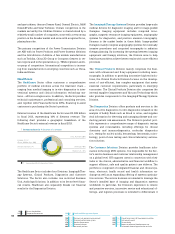Siemens 2013 Annual Report Download - page 164
Download and view the complete annual report
Please find page 164 of the 2013 Siemens annual report below. You can navigate through the pages in the report by either clicking on the pages listed below, or by using the keyword search tool below to find specific information within the annual report.
92 A. To our Shareholders
117 B. Corporate Governance 155 C. Combined Management Report
156 C. Business and economic environment
173 C. Financial performance system
179 C. Results of operations
192 C. Financial position
204 C. Net assets position
207 C. Overall assessment of the economic position
209 C. Subsequent events
210 C. Sustainability
227 C. Report on expected developments and
associated material opportunities and risks
The Low and Medium Voltage Division supplies electrical
grid operators, large industrial electricity consumers and con-
struction markets with medium and low-voltage electrical
power equipment. Furthermore, the Division provides prod-
ucts, systems and services for distributing electrical power
from high-voltage transmission grid access to medium or
low-voltage grids and for directing electrical power to end con-
sumers and their access points. Medium voltage equipment
includes distribution switchgear, control gear, circuit breakers
and components for distributing and switching of electrical
power coming from the high voltage transmission grid to the
medium voltage distribution grid and within the medium volt-
age grid itself. The low voltage portfolio consists of power dis-
tribution boards, busbar trunking systems, distribution boards
and terminal blocks, as well as products for protecting, switch-
ing, measuring and monitoring devices and socket outlets.
The Smart Grid Division provides energy automation solu-
tions, smart grid applications, transmission and distribution
services and rail infrastructure electrification solutions for
mainline and mass transit applications. In addition, the Divi-
sion offers meter data management solutions and services
relating to the planning of electric network grids and the oper-
ation and maintenance of transmission and distribution prod-
ucts, systems and solutions.
The Building Technologies Division offers products, services
and solutions for commercial, industrial, public and residential
buildings. Primary applications include building operation and
automation, comfort, safety and security. In addition, t
he Divi-
sion offers energy solutions and energy management ser-
vices aimed at improving a building’s energy cost, reliability,
comfort and performance, while minimizing its impact on
the en vironment. The Division’s offerings include heating
and ventilation controls, security systems and devices for
intruder detection, video surveillance and building access
control, total room automation systems, and fire safety solu-
tions for fire detection, protection alarms and non-water-
based fire extinguishing.
Until the end of fiscal , the Infrastructure & Cities Sector
also held the Atos S.A. (AtoS) shares, which Siemens received
following the sale of Siemens IT Solutions and Services to
AtoS. Due to a change in management responsibility related to
Siemens’ shares in AtoS, the shares have been included within
Equity Investments since the beginning of fiscal .
The Infrastructure & Cities Sector distributes its products and
services through its own dedicated sales force, supported by
Siemens’ worldwide network of regional companies. In addi-
tion, the Divisions of the Sector use, to varying degrees,
third-party distributors, panel builders, original equipment
manufacturers, value added partners, installers and general
contractors.
Overall, the Sector’s principal customers are industrial, infra-
structure and public customers in a broad range of markets,
including construction and real estate, transportation and
logistics and utilities. The timing and extent to which a Divi-
sion of the Infrastructure & Cities Sector is affected by econom-
ic cycles depends largely on the kind of business activities it
conducts. Business activities that tend to react very quickly to
changes in the overall economic environment include those in
the Low and Medium Voltage Division. Business activities that
are generally affected later by changes in the overall economic
environment include those in the Smart Grid and Building
Technologies Divisions. The development of markets served by
our Divisions Rail Systems, Mobility and Logistics and parts of
Smart Grid is driven primarily by public spending. Customers
of these Divisions usually have multi-year planning and imple-
mentation horizons, and their contract tenders therefore tend
to be independent of short-term economic trends.
The Sector’s principal competitors are multinational com-
panies such as ABB, Alstom, Ansaldo, Bombardier, General
Electric, Honeywell, Johnson Controls, Schneider Electric and
Tyco. The Sector’s competitors vary by Division. The main com-
petitors of the Rail Systems Division and the Mobility and
Logistics Division are Alstom, Ansaldo STS, Bombardier and
General Electric. The primary competitors of the Low and
Medium Voltage Division are ABB, Eaton and Schneider Elec-
tric. The principal competitors of the Smart Grid Division are
ABB, Alstom, General Electric and Schneider Electric. The main
competitors of the Building Technologies Division are Honey-
well, Johnson Controls, Schneider Electric and Tyco. Infra-
structure & Cities also faces competition from niche compe-
titors and from new entrants, such as utility companies
and consulting firms, exploiting the fragmented energy effi-
ciency market. The Sector’s solution businesses also compete
with engineering, procurement and construction providers,
and competitors in the service field often include small local
players.
Equity Investments
In general, the segment Equity Investments comprises equity
stakes held by Siemens that are accounted for by the equity
method, at cost or as current available-for-sale financial assets
and for strategic reasons are not allocated to a Sector, SFS, Cen-
trally managed portfolio activities, Siemens Real Estate (SRE),
Corporate items or Corporate Treasury. Our main investments
























